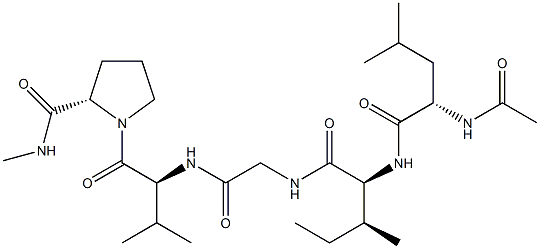ELASTIN
- CAS NO.:9007-58-3
- Empirical Formula: C27H48N6O6
- Molecular Weight: 552.70662
- MDL number: MFCD00130999
- EINECS: 232-701-4
- SAFETY DATA SHEET (SDS)
- Update Date: 2024-10-30 18:52:02

What is ELASTIN?
Description
Writing in the Encyclopedia of Biological Chemistry II, biochemist Judith Ann Foster of Boston University describes elastin as
a protein that exists as fibers in the extracellular spaces of many connective tissues. Elastin derives its name from its ability to act as an elastic band, that is, to stretch and recoil with transient force. It is located throughout many tissues and organs of higher vertebrates and plays an important functional role in maintaining pressures associated with liquid and air flow in the cardiovascular and pulmonary systems.
Elastin takes many forms and compositions depending on its location in the organism. In a 1938 report on the composition of elastin, William A. Stein and Edgar G. Miller, Jr., at Columbia University (New York City) identified and quantified 10 amino acids, the most abundant of which were glycine and leucine.
The images show one of the common structures within elastin: the peptide chain N-acetyl-L-leucyl-L-isoleucyl-glycyl-L-valyl-L-proline methylamide. Although components of elastin, called tropoelastins, are water-soluble, the large elastin protein is not.
In some respects, elastin is similar to titin, the Molecule of the Week for November 7, 2022. In humans, titin is encoded by the TTN gene in chromosome 2; elastin is coded by ELN in chromosome 7.
For additional information on elastin, see ScienceDirect’s abstract page.
The Uses of ELASTIN
elastin (hydrolyzed) is a modified form of elastin that has better solubility, and thus is more convenient for use in cosmetic formulations than regular elastin.
The Uses of ELASTIN
elastin is a surface protective agent used in cosmetics to alleviate the effects of dry skin, enhance skin flexibility, improve skin feel, increase and improve the tension of the skin, and influence the formation of tropocollagen fibers when used in combination with soluble collagen. Preparations containing elastin and peptides derived from it are reported to promote wound healing. Reportedly, in such systems, elastin can absorb lipids from the skin, and when applied to scars, increase the structural glycoproteins and elastin available in the scar tissue. elastin is an elastic structural protein found in the dermis together with collagen, and is difficult to obtain in pure form. Collagen and elastin are similar, although elastin has a different amino acid composition and is found in lower concentrations. Its molecular size is also much smaller than collagen’s, and as a result, there is a tendency to believe that it penetrates the surface epidermal layers, thereby improving overall skin appearance, softness, and suppleness. elastin is often used in moisturizing products and those products for aging or mature skin.
The Uses of ELASTIN
Elastin mouse lung has been used as an extracellular matrix (ECM) protein for coating of plates.
Definition
A fibrous protein that is themajor constituent of the yellow elasticfibres of connective tissue. It isrich in glycine, alanine, proline, andother nonpolar amino acids that arecross-linked, making the protein relativelyinsoluble. Elastic fibres canstretch to several times their lengthand then return to their original size.Elastin is particularly abundant inelastic cartilage, blood-vessel walls,ligaments, and the heart.
General Description
Elastin is an extracellular matrix protein encoded by the gene ELN, which is mapped to human chromosome 7q11.23. Elastin is a major protein component of elastic fibres and is synthesized from the precursor protein called tropoelastin. Elastin is present in all the vertebrates except for the primitive fish. Elastin is majorly composed of glycine, proline and other hydrophobic residues.
General Description
Elastin is an insoluble extracellular matrix protein and the core protein of elastic fibers that impart elasticity to skin. Histologically, an accumulation of disintegrated amorphous elastic fibers is observed in the solar elastosis region. Elastin is secreted as tropoelastin in the extracellular matrix. The biologic process of elastic fibers is complicated. It has multiple components and is assembled via several steps and stringently regulated developmental processes.
Biochem/physiol Actions
Protein responsible for the elasticity of many tissues. It is especially important in blood vessels, where it comprises about 50% of the dry tissue weight.
Properties of ELASTIN
| Melting point: | n/a |
| storage temp. | 2-8°C |
| solubility | H2O: soluble |
| form | powder |
| appearance | pale yellow fibers |
Safety information for ELASTIN
Computed Descriptors for ELASTIN
| InChIKey | DPUYCSDGMSDKKV-XPEWSIIXNA-N |
| SMILES | N1(C(=O)[C@@H](NC(CNC(=O)[C@@H](NC(=O)[C@@H](NC(=O)C)CC(C)C)[C@@H](C)CC)=O)C(C)C)CCC[C@H]1C(NC)=O |&1:3,10,14,23,34,r| |
New Products
4-AMINO-TETRAHYDRO-PYRAN-4-CARBOXYLIC ACID HCL 4-(Dimethylamino)tetrahydro-2H-pyran-4-carbonitrile 4-Aminotetrahydropyran-4-carbonitrile Hydrochloride (R)-3-Aminobutanenitrile Hydrochloride 3-((Dimethylamino)methyl)-5-methylhexan-2-one oxalate 1,4-Dioxa-8-azaspiro[4.5]decane 5-Bromo-2-nitropyridine Nimesulide BP Aceclofenac IP/BP/EP Diclofenac Sodium IP/BP/EP/USP Mefenamic Acid IP/BP/EP/USP Ornidazole IP Diclofenac Potassium THOMAIND PAPER PH 2.0 TO 4.5 1 BOX BUFFER CAPSULE PH 9.2 - 10 CAP SODIUM CHLORIDE 0.1N CVS ALLOXAN MONOHYDRATE 98% PLATINUM 0.5% ON 3 MM ALUMINA PELLETS (TYPE 73) LITHIUM AAS SOLUTION 2-Bromo-1-(bromomethyl)-3-chloro-5-nitrobenzene 2-Bromo-3-nitroaniline N-(3-Hydroxypropyl)-N-methylacetamide 3-Bromo-6-chloropyridazine 4-ethyl-3-nitrobenzoic acidRelated products of tetrahydrofuran








You may like
-
 Elastin from bovine neck ligament CAS 9007-58-3View Details
Elastin from bovine neck ligament CAS 9007-58-3View Details
9007-58-3 -
 Elastin, soluble from bovine neck ligament CAS 9007-58-3View Details
Elastin, soluble from bovine neck ligament CAS 9007-58-3View Details
9007-58-3 -
 1823368-42-8 98%View Details
1823368-42-8 98%View Details
1823368-42-8 -
 2-(3-(tert-butyl)phenoxy)-2-methylpropanoic acid 1307449-08-6 98%View Details
2-(3-(tert-butyl)phenoxy)-2-methylpropanoic acid 1307449-08-6 98%View Details
1307449-08-6 -
 Ethyl 3-(furan-2-yl)-3-hydroxypropanoate 25408-95-1 98%View Details
Ethyl 3-(furan-2-yl)-3-hydroxypropanoate 25408-95-1 98%View Details
25408-95-1 -
 2-Chloro-5-fluoro-1-methoxy-3-methylbenzene 98%View Details
2-Chloro-5-fluoro-1-methoxy-3-methylbenzene 98%View Details
1805639-70-6 -
 1784294-80-9 98%View Details
1784294-80-9 98%View Details
1784294-80-9 -
 Lithium ClavulanateView Details
Lithium ClavulanateView Details
61177-44-4